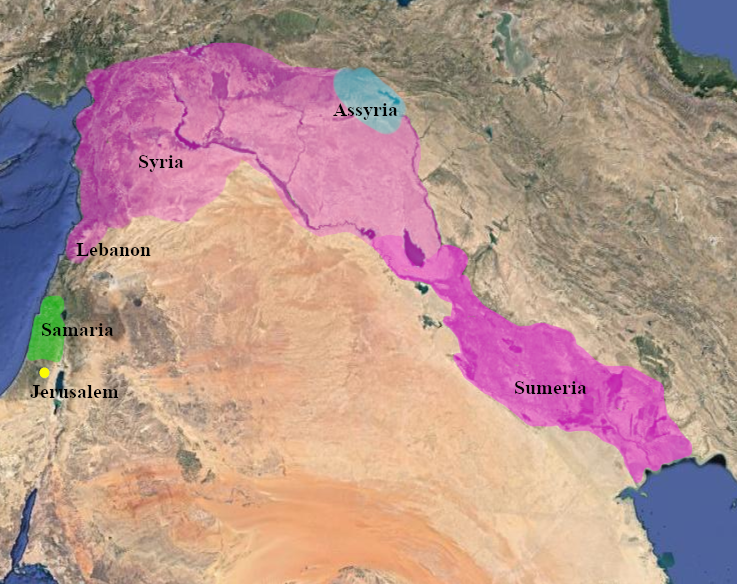semeron
שמרונ
Also pronounced “Shomron”, Shemerun is typically understood to mean the area of Samaria. Notice however, the etymological similarity between the words Samaria and Sumeria.
From the perspective of the Israelite homeland centered around Jerusalem, both Samaria and Sumeria are lands directly to the north. In simple geography, from the perspective of Israel/Canaan, Samaria is clearly the region immediately to the north. Less obviously, if you keep going north beyond that, you hit the more ancient lands of Sumeria (Sumer), in Mesopotamia.
By now the astute observer may be thinking they have found an error. According to this map, Sumeria is not north of Jerusalem at all. Instead it is almost due East of Jerusalem.
However, one has to consider the geography of the area and the transportation routes available during ancient times. In order to go East, you had to travel North.
Ancient Mesopotamia consisted of the entire area between the Euphrates and the Tigris rivers, which was more or less occupied continuously by a long series of political conglomerates and hierarchies composing what we now think of as distinct cultures; Sumer, Assyria, Akkad, Babylon, Persia, Edessa, and others. Regardless of who happened to be in charge and what particular political agendas they may have had, there was a surprising cultural continuity across these varied regimes. Whatever the political climate of the day, the physical climate was one of imposing stability; a vast desert cut by two mighty rivers whose courses defined the landscape both geographically and culturally. While the powers that be faought amongst themselves, the vast majority of the population just kept farming like they always had and sent in their taxes to whoever the new guy on the throne happened to be.
These two rivers provided an obvious transportation route and acted as highways into the rich heartlands of the Caucasus mountains and Armenian highlands. From there, ancient trading routes followed the Mediterranean coast and the Jordan River south, eventually linking to Egypt.
So if one were to start in Israel and head north, they would very quickly enter Samaria - “the Shemerun”. Continuing north, the “superhighway” trade route bends slightly to the north-east and boards rafts heading downriver to Sumeria - “the Shemerun”.
The Shemerun then is both Samaria and Sumeria, and in fact, these two place names are really the same word, merely with a local accent applied. And because this word is clearly based on the root word shem, as a place name this is “land of the semim” - “Shemeria”. Three slightly different accents for the same word, which refers to the land of the Shemim. The Shemim being an ancient “legendary” group of individuals, who came from the northern trade routes, having originated somewhere in one of the areas called “Shemeria”, most likely “Sumeria”, and probably whose later migratory descendents also settled in “Samaria” (aka Canaan, aka Palestine).
However, there is another layer to this story. The semim are “the legendary ones”. And 'semeron' therefore is the land of the legendary ones. In other words, the land where the ancient legends took place. What legends are referred to? It doesn't take a great leap of the imagination to see that the legendary lands where the ancient legends took place are none other than those of the ancient Mesopotamian myths - the lands of the Sumerians. Therefore, the semim are the very characters referred to in the ancient legends of the Sumerian culture. They are quite literally the legendary ones. The ones whose stories had travelled along the trade routes and migration routes and had already become such a staple of the local culture (in Israel) that their identities are immediately known simply by reference to “those legendary characters” the semim. With this in mind, our examination of the semim truly ought to be overlain on the extant bounty of Sumerian/Akkadian/Babylonian mythology. However given the nature of this particular project as a Bible Dictionary it may not seem appropriate to delve into non-Hebraic culture under the auspices this particular umbrella. Perhaps some of our contributors might consider it as a side project.

This page is part of a series on geography
LexID 8111

